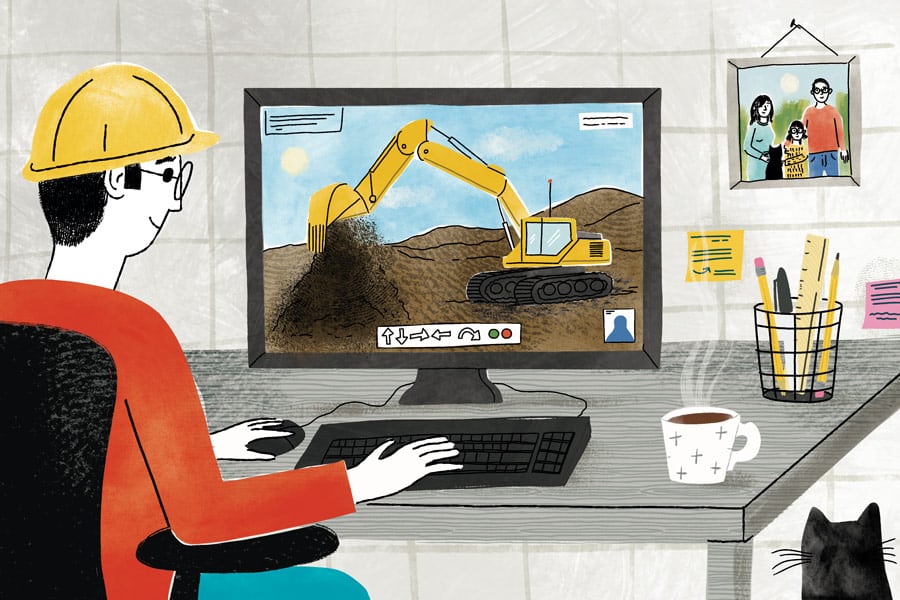Illustration by Lindsay Gruetzmacher
The COVID-19 pandemic forced an immediate rush toward remote and hybrid work—even in construction. While carpenters and bricklayers remained on jobsites, construction companies sent a slew of other employees home, from engineers to estimators.
Now, as pandemic safety measures lift, employers are calling for a return to cubicles and conference rooms. But that’s not what many employees want. According to professional services firm PwC’s recent remote work survey, some 55% of respondents said they’d like to work remotely at least three days a week. Other surveys show people more willing to quit their jobs entirely rather than return to the office.
That friction between employers and employees is prompting some workers to look for new gigs, said Nicole Snelling, senior diversity recruiter at Ryan Companies, a national construction, development and design firm.
Ryan is allowing remote work to continue where possible, and Snelling said she’s meeting with job candidates who want to leave their current employer because it won’t allow even a hybrid schedule that mixes time inside and outside the office.
In an industry that already needs 430,000 more workers to keep up with demand, according to a report from trade organization Associated Builders and Contractors, those personnel losses can add up. This is primarily the reason why construction companies need to look at crafting hybrid work policies even when the risks of COVID-19 dissipate.
“They’re saying, literally, ‘I don’t want to go back. My current employer is making me and that doesn’t sit with me right now,’” Snelling said. “It just feels very micromanage-y at this point through all that we’ve been able to endure through this pandemic. … We’ve been able to put our heads down and do good work—and company leaders that can’t recognize that and appreciate that, they’re going to lose them and we’re going to gain them.”
Back to field trailers, pickup trucks
Allowing for a hybrid workforce outside of a global health crisis can require a mindset shift for some employers that worry about productivity or company culture. But research shows many of those worries are misplaced.
A Mercer survey of almost 800 companies found that 94% of employers agree that productivity has remained the same or improved since companies started working remotely. And in a report on the future of work after COVID-19, global management consulting firm McKinsey found that 15% to 20% of construction employees’ time is spent on tasks that can be done remotely.
Finally, while some leaders argue in-person work brings spontaneous conversation among colleagues that doesn’t always exist when workers are remote, there’s scant evidence that such at-work interactions make companies more productive or innovative.
Estimators, schedulers, project managers and office administrators are among the individuals with the potential for remote or hybrid schedules, experts say. Some may be required to occasionally check in on jobsites. But if they already were mixing field work with office work, there’s no reason why that office must be inside company headquarters.
With a continued move toward remote and hybrid work, experts see benefits for employers beyond happier workers. No longer tied to costly headquarters, construction firms can spend money on IT purchases that make remote work easier and boost efficiency in other ways.
Virtual reality tools, for instance, let workers check in on a project’s progress from their computer. Drones are also increasingly used for remote inspections and quality control.
Modeling flexibility
Building a workplace where hybrid schedules are not just allowed, but welcomed, also requires some intentional planning, said Evelyn Lee, a senior experience designer at workplace communications technology company Slack, who also is founder of Practice of Architecture, advising architecture firms on management issues.
Technology that gives everybody access to the same tools that office workers have is critical. So is ensuring that team meetings allow for both in-person and remote participation. Leaders also must demonstrate that it’s OK to work from home.
[ALSO ON BUILT:]
“If you have a flexible workplace policy, but you’re showing up every single day from 9 a.m. to 5 p.m., you’re modeling behavior that the only way to become a leader in this firm is to show up in the office every day,” said Lee, whose courses include how to run a hybrid architecture practice.
Crafting the right policies
Of course, not every worker can remain at home all the time. Companies need to be careful as they create hybrid and remote work policies to ensure fairness and avoid discrimination claims.
Leanne Fuith, associate professor at Mitchell Hamline School of Law at Hamline University in Saint Paul, Minnesota, and an employment law expert, recommended the following steps:
Think equality: Be careful that policies don’t have adverse impacts on one category of employee, such as women or people of color, Fuith said. Consider hiring a lawyer or HR expert to ensure the policies are well crafted and address applicable local, state and national employment laws.
Consider job descriptions: Job responsibilities often are fluid, especially in small businesses. Fuith recommends taking a hard look at each role to ensure job descriptions are accurate. When they correctly describe a job’s tasks, employers can identify which parts of a job, if any, can be done remotely and set the appropriate policies.
Be consistent: Workplace policies that allow for a more flexible experience require thoughtful communication, Fuith said. Leadership must regularly provide an overview of policies and expectations. Managers should take that message and communicate it again to smaller groups of employees. And HR needs to ensure that the stated policies are consistently followed.
At Ryan, Snelling expects to see more job candidates ready to make the move to a company that values a hybrid workforce. And it’s not just because they like skipping the commute, she said.
After surviving a global health crisis, workers have become more thoughtful about what matters most to them, discovering that their current company is no longer a fit.
“They’re realizing values don’t align. This company doesn’t get it. Leadership doesn’t get it. They’re out of touch,” Snelling said. “So, I’m not willing to give my hard work, effort or energy anymore to a company that doesn’t really listen to me or wants to know what’s important to me. Our company gets it, fortunately.”












